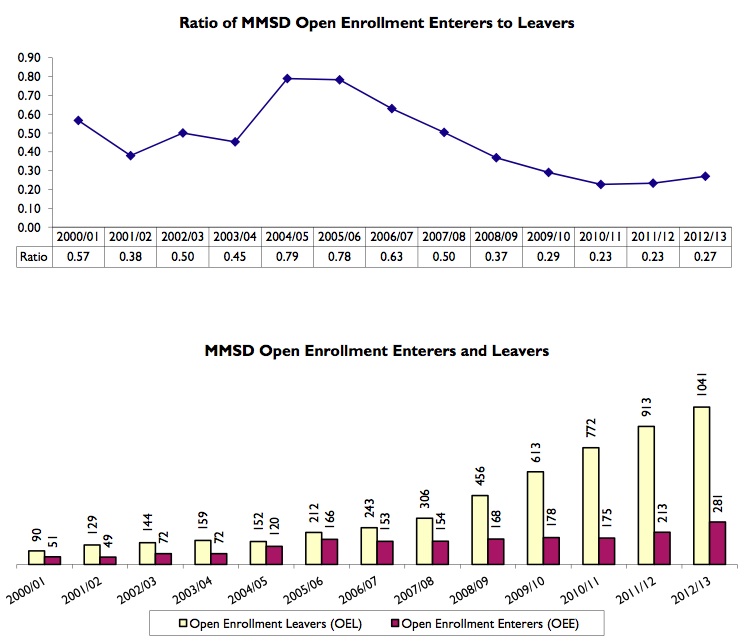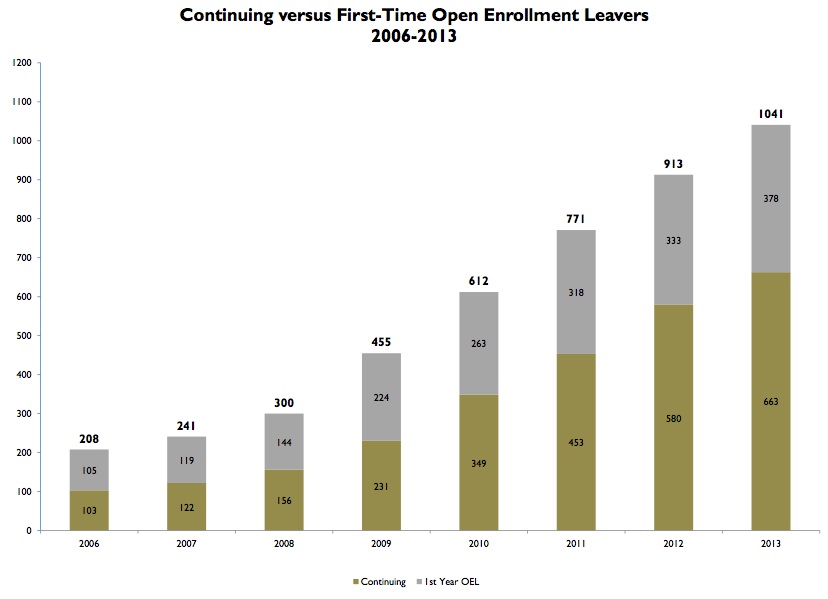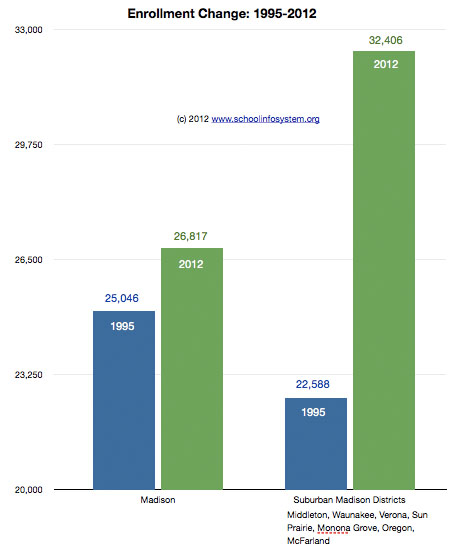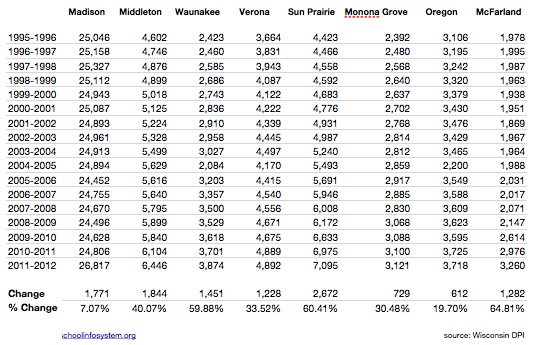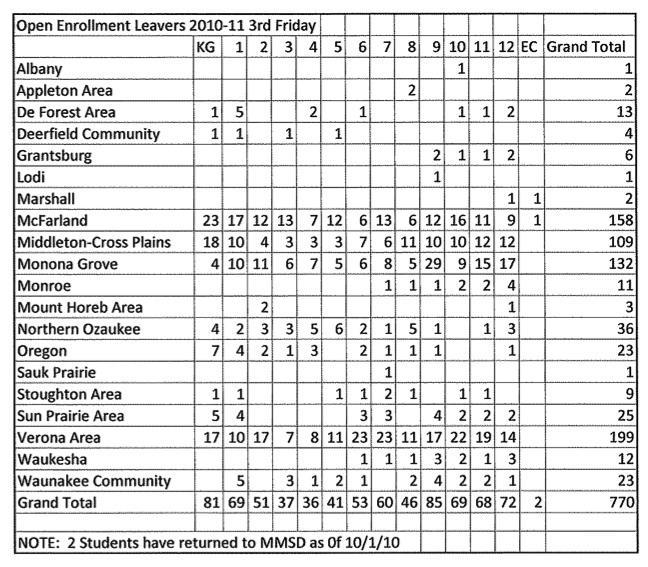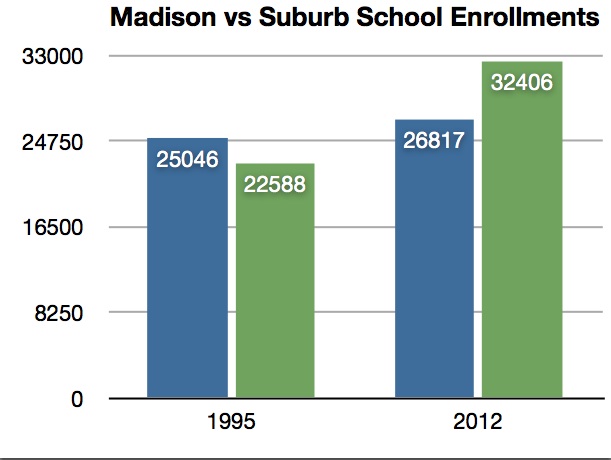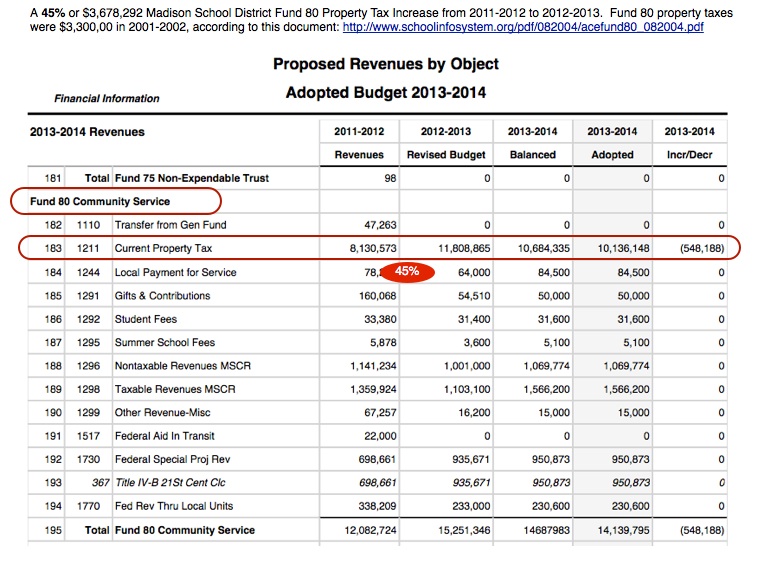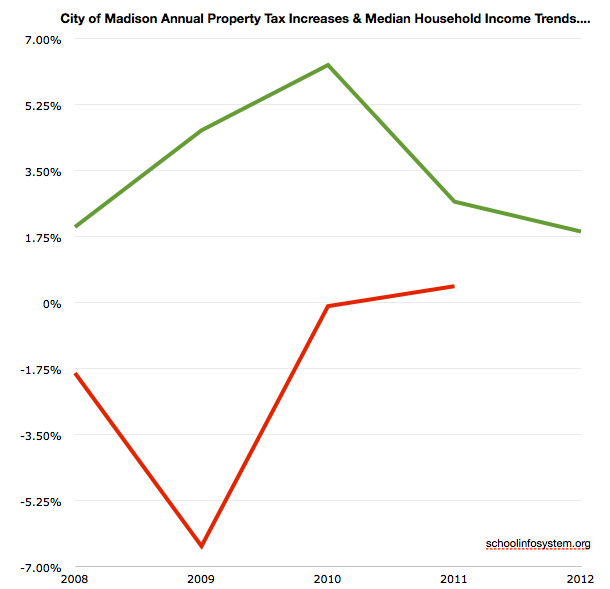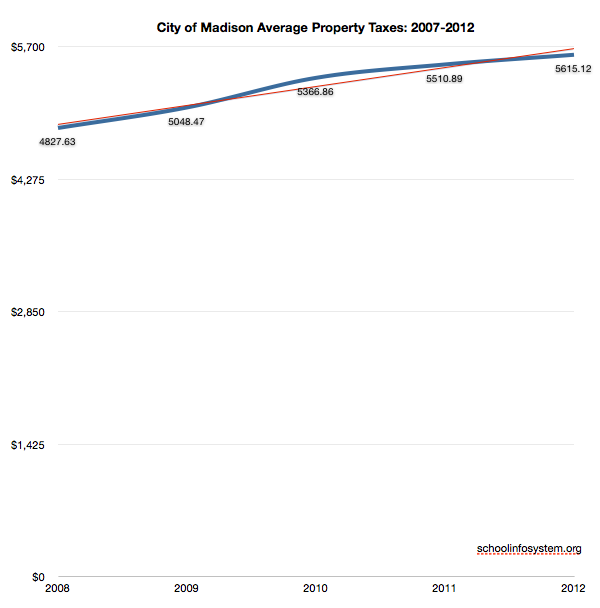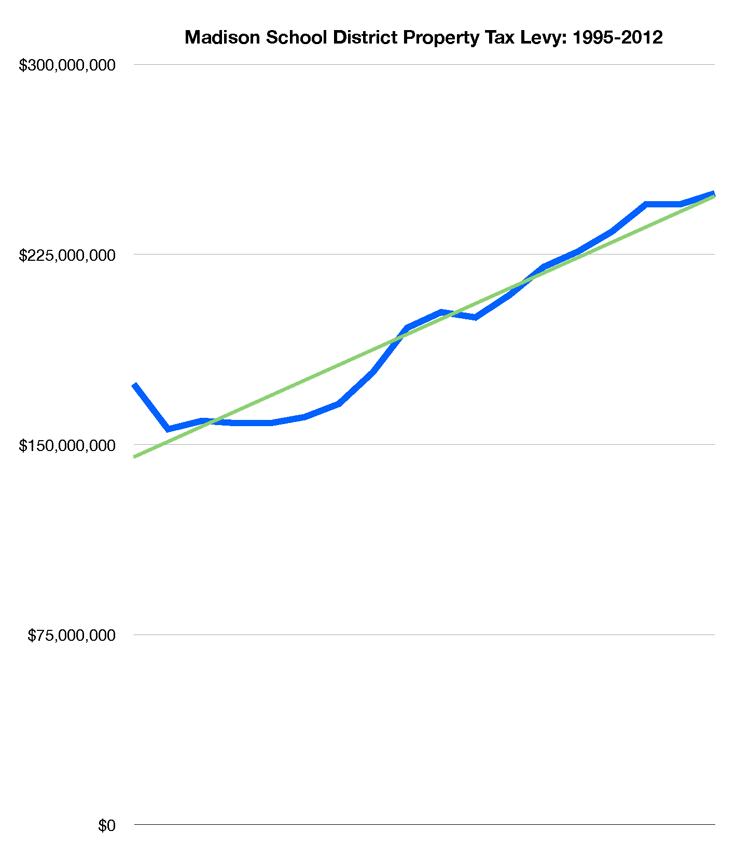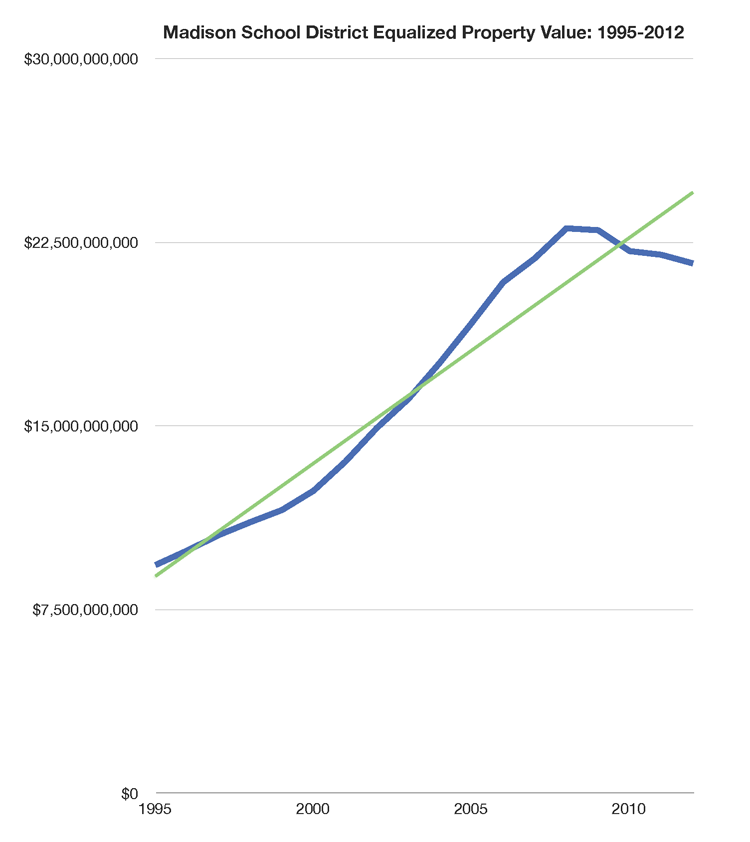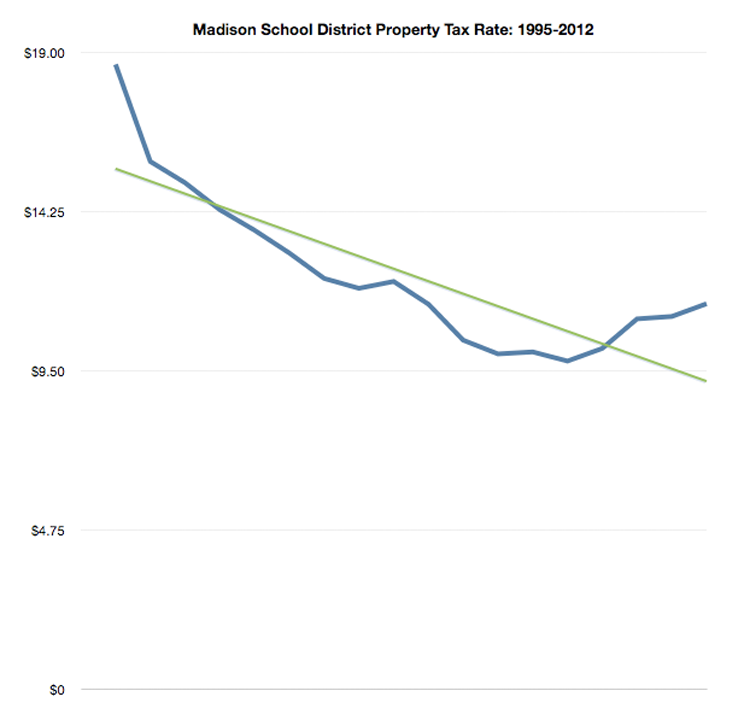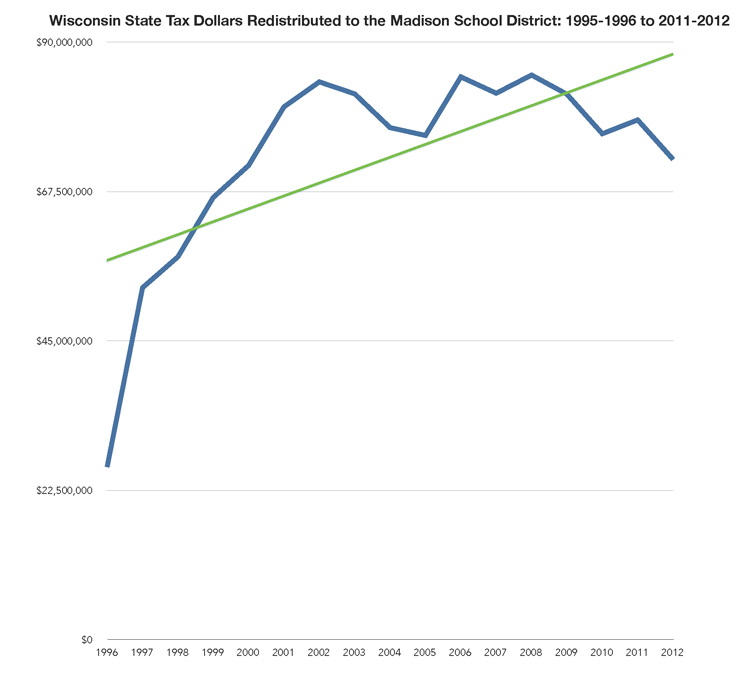Search Results for: open enrollment leavers
Madison School District Open Enrollment Leavers Report, 2012-13
Superintendent Jane Belmore (700K PDF):For the 2012-13 school year, MMSD has 1041 leavers and 281 enterers for a net enrollment decrease of 760 students due to open enrollment.
Of the 1041 leavers for 2012-13, 663 were “continuing leavers” who open enrolled outside of the District in previous years. The other 378 leavers left MMSD for the first time this year.
The increasing number of total leavers in recent years results from many consecutive years of increases in first-time leavers who subsequently become continuing leavers.
First time leavers increased from 333 to 378 from 2011-12 to 2012-13.
About 40% of the MMSD residents who open enroll outside of the district for the first time never attended MMSD and could be considered “stayers” for other districts.
A 2009 survey of open enrollment leavers showed that personal preference led to about one third of the decisions to leave, including concerns about safety, drugs and negative peer pressure. Proximity to other districts’ schools accounts for about a quarter of the reasons for attending another district. About a quarter were related to curricular, after school or virtual programs.Related: Much more on “open enrollment”, here, and the Madison School District’s enrollment forecast (PDF).
Madison School District Open Enrollment Enterers & Leavers
Under Open Enrollment, students may transfer into an MMSD school from another district or transfer out to another district – “enterers” versus “leavers.” This report focuses primarily on Open Enrollment leavers. There is also some discussion of the net effect of Open Enrollment, which is the number of leavers minus the number of enterers. This report does not discuss students attending private/parochial schools or home schooled students.
For the 2011-12 school year, MMSD has 913 leavers and 213 enterers for a
net effect of 700 students choosing to attend a district other than MMSD.
Of the 913 leavers for 2011-12, 580 were “continuing leavers” meaning they open enrolled outside of the District in previous years. That leaves 333 first time leavers for the current school year.
The growing number of leavers in recent years is the result of a cumulative increase over several years – those who are continuing leavers are still included in our counts in the following years. Because of this, it will take time to reverse the net number of leavers and first time leavers are of particular interest.
First time leavers increased only slightly from 2010-11 to 2011-12. If we discount the one-time bump for the first class of 4K, the number of first time leavers went down for the first time since at least 2005-06.
It is also important to note that nearly half of the students that are leavers never attended MMSD and could be considered “stayers” for other districts.
In terms of why people leave the district, we rely on a 2009 survey of leavers.
Declining District Enrollment? Here’s a No-Brainer: Ask Why Families Left — And Listen When They Answer
Beth Hawkins: Do you want to know what happens when you pull your child out of Minneapolis Public Schools? Nothing. That’s what happens. No first-week phone call from the school office or the enrollment center. No social worker wondering if things are okay. Not so much as a multiple-choice survey asking what prompted you to […]
Open Enrollment Survey and Data Update – Madison School District
Madison School District Administration (PDF): 1. In total, MMSD has 365 open enrollment enterers and 1294 open enrollment leavers for 2016-17; among those 1294 leavers, 58% have never enrolled in an MMSD school. 2. The net effect of open enrollment decreased by 70 students. The number of open enrollment leavers decreased by 21 students and […]
Madison Student Enrollment Projections and where have all the students gone?
Madison School District PDF: Executive Summary: As part of its long-range facility planning efforts, MMSD requires a refined approach for predicting enrollment arising from new development and changes in enrollment within existing developed areas. As urban development approaches the outer edges of the District’s boundary, and as redevelopment becomes an increasingly important source of new […]
2015-2016 Madison Traditional Public Schools’ Enrollment Data
Madison School District Administration (PDF): 1. Enrollment is down slightly (0.3%) since last year. Enrollment projection begin to climb again in 2017-18. 2. Six elementary schools are over capacity this year. Referendum-funded construction eliminates overcrowding among these schools in the five-year projection. 3. Most students continue to attend their home attendance area. This year 60% […]
An Update on Open Enrollment & The Madison Schools
Molly Beck: There are 1,203 students living within the Madison School District’s boundaries who have enrolled in other school districts this school year — about 62 more than last year. The number of students from other districts who enrolled in Madison schools is 372, up by about 73. The net effect is a loss of […]
Which Madison schools are losing the most students to open enrollment?
he number of students that have left Madison schools for other districts through the state’s public school open enrollment program has grown every year since 2005.
But which schools are those students leaving? Our graphic below uses Madison Metropolitan School District data to show the number of leavers — the term used for students who live in the Madison district but go to school in another — by which school’s attendance area they live in. (Note that the open enrollment program doesn’t apply to students who leave for private schools or to be home-schooled.)
By percentage of enrollment, the schools with the most leavers were Glendale Elementary (83, 17.5 percent), Leopold Elementary (67, 10.2 percent), Toki Middle (48, 9.4 percent) and La Follette High (121, 8.2 percent). Memorial High has the highest number of leavers at 134, but its higher enrollment put it only eighth when ranked by percentage (7.3 percent).
Of the 1,041 leavers for the 2012-13 school year, 494 were from elementary schools, 188 were in the middle school grades 6 through 8 and 359 were at the high school level.
The Monona Grove School District was the most popular destination for the leavers, followed closely by Verona and McFarland. Students left Madison for 25 districts, but data for how many attended each was not fully available because the district can’t report small numbers due to privacy concerns.Much more on outbound open enrollment here.
Paul Vallas visits Madison; Enrollment Growth: Suburban Districts vs. Madison 1995-2012
Related:
- Where Have All the Students Gone (November, 2005)?
- Where Have all the Students Gone? An Update (January, 2008)
- Madison School District Outbound Open Enrollment.
- Open Enrollment Leavers Survey
Paul Vallas will be speaking at Madison LaFollette high school on Saturday, May 26, 2012 at 1:00p.m. More information, here.
Much more on Paul Vallas, here.
Directions.
Per Student Spending:
I don’t believe spending is the issue. Madison spends $14,858.40/student (2011-2012 budget)
Middleton’s 2011-2012 budget: $87,676,611 for 6,421 students = $13,654.67/student, about 8% less than Madison.
Waunakee spends $12,953.81/student about 13% less than Madison.
A few useful links over the past decade:
- Notes and links on Madison Superintendent hires since 1992 (2007).
- English 10
- Small Learning Communities
- Connected Math
- Reading Recovery
- When all third graders read at grade level or beyond by the end of the year, the achievement gap will be closed…and not before
- Madison School Board member may seek audit of how 2005 maintenance referendum dollars were spent
- Madison Preparatory Academy
Madison School District 2010-2011 Enrollment Report, Including Outbound Open Enrollment (3.11%)
136K PDF
A few numbers:
Total District Enrollment 24,796 (The Wisconsin DPI enrollment number for Madison is 25,395).
Open Enrollment Leavers: 772
Open Enrollment Enterers: 175
Much more on outbound open enrollment here.
Tax & spending authority are largely based on enrollment.
The most recent 2010-2011 budget document indicates total planned spending of $373,157,148, which yields $15049.08 per student.
Madison’s public schools go to lockdown mode; no new ideas wanted
Graphical user interface? I think not, Mr. Jobs. Mainframe is where it’s at. Big and honking, run by guys in white lab coats. Smart phones? iPads? You’re dreaming. Take your new ideas somewhere else.
That is the Madison School Board. It has decided to batten the hatches against change. It is securing the perimeter against new thinking. It is the North Korea of education: insular, blighted, and paranoid.
Just try to start a charter school in Madison. I dare you. The Madison School Board on Monday took three measures to strangle new ideas in their crib:
1) Preserving the status quo: Any proposed charter school would have to have “a history of successful practice.” That leaves out several existing Madison public schools – never mind new approaches.
2) Starvation: Cap per-pupil reimbursement at around $6,500 – less than half what Madison public schools consume.
3) Encrustation: Unionized teachers only need apply.
I spoke to Carrie Bonk, executive director of the Wisconsin Charter Schools Association.Related:
Madison’s disastrous reading results.The rejected Studio charter school.
Minneapolis teacher’s union approved to authorize charter schools.
“We are not interested in the development of new charter schools”.
Notes and links on the rejected Madison Preparatory Academy IB Charter School.
Madison School District Open Enrollment Leavers Report, 2012-13.
Madison’s disastrous long term reading results..
Interview: Henry Tyson, Superintendent of Milwaukee’s St. Marcus Elementary School.
Madison’s School Board to Finalize “Charter School Policy”……
Dylan Pauly, Legal Counsel Steve Hartley, Chief of Staff (PDF):
It is the policy of the School Board to consider the establishment of charter schools that support the DISTRICT Mission and Belief Statements and as provided by law. The BOARD believes that the creation of charter schools can enhance the educational opportunities for Madison Metropolitan School District students by providing innovative and distinctive educational programs and by giving parents/students more educational options within the DISTRICT. Only charter schools that are an instrumentality of the DISTRICT will be considered by the BOARD.
The BOARD further believes that certain values and principles must be integrated into all work involving the conceptualization, development and implementation of a new charter school. These guiding principles are as follows:
1. All charter schools must meet high standards of student achievement while providing increased educational opportunities, including broadening existing opportunities for struggling populations of students;
2. All charter schools must have an underlying, research-based theory and history of successful practice that is likely to achieve academic success;
3. All charter schools will provide information to parents and students as to the quality of education provided by the charter school and the ongoing academic progress of the individual student;
4. All charter schools will ensure equitable access to all students regardless of gender, race and/or disability;
5. All charter schools must be financially accountable to the DISTRICT and rely on +’ sustainable funding models;
6. All charter schools must ensure the health and safety of all staff and students;
7. All externally-developed charter schools must be governed by a governance board that is registered as a 501(c)(3), tax-exempt charitable organization;
8. All charter schools must have a plan to hire, retain and recruit a highly-qualified, diverse staff;
9. All charter schools must have a clear code of student conduct that includes procedures for positive interventions and social emotional supportsRelated:
Matthew DeFour’s article.
The rejected Studio charter school.
Minneapolis teacher’s union approved to authorize charter schools.
“We are not interested in the development of new charter schools”.
Notes and links on the rejected Madison Preparatory Academy IB Charter School.
Madison School District Open Enrollment Leavers Report, 2012-13.
Madison’s disastrous long term reading results..
Interview: Henry Tyson, Superintendent of Milwaukee’s St. Marcus Elementary School.
Madison’s thriving private schools buck national trend
Private school enrollment has steadily declined across Wisconsin over the past 15 years, but that’s not the case in Madison and Dane County.
St. Ambrose Academy, a West Side Catholic middle and high school, has been rapidly expanding and is discussing the addition of an elementary school. EAGLE School is planning a $3 million expansion at its Fitchburg campus with the goal of increasing its student body by a third. And High Point Christian School on Madison’s Far West Side is full, so some students board a bus there and travel across town to its sister campus on the Far East Side.
“The Madison metropolitan area is definitely bucking the national trend,” said Michael Lancaster, superintendent of Madison Catholic Schools. “I wouldn’t say we’re growing at any kind of geometric or exponential rate. But we’re very solid in the Madison area.”
The vitality of local private schools could help explain the muted level of interest in Madison for the publicly funded voucher expansion proposed in Gov. Scott Walker’s biennial budget. Vouchers also face intense opposition from Dane County political and public school leaders.
Voucher expansion
Walker has proposed expanding the state’s voucher program from Milwaukee and Racine to school districts with more than 4,000 students and at least two schools with low ratings on the state’s new school report card. Based on the first report cards released last fall, students in Madison and eight other districts would qualify for vouchers.
On March 4, the Wisconsin Council of Religious and Independent Schools held the first public voucher meeting in Madison at St. James Catholic School on the Near West Side. Fewer than 10 parents and private school administrators attended.
A similar meeting last week in Beloit, a smaller city with far fewer private schools, drew about 40 people, WCRIS executive director Matt Kussow said.The largest challenge to Madison’s $392,000,000 public schools is not the threat of vouchers. Rather, it is the District’s long time disastrous reading results that undermine its prospects and reputation.
Suburban district growth and open enrollment leavers are also worth contemplation and action.
“We are not interested in the development of new charter schools”
Larry Winkler kindly emailed the chart pictured above.
Where have all the Students gone?
Madison Mayor Paul Soglin:We are not interested in the development of new charter schools. Recent presentations of charter school programs indicate that most of them do not perform to the level of Madison public schools. I have come to three conclusions about charter schools. First, the national evidence is clear overall, charter schools do not perform as well as traditional public schools. Second where charter schools have shown improvement, generally they have not reached the level of success of Madison schools. Third, if our objective is to improve overall educational performance, we should try proven methods that elevate the entire district not just the students in charter schools. The performance of non-charter students in cities like Milwaukee and Chicago is dismal.
In addition, it seems inappropriate to use resources to develop charter schools when we have not explored system-wide programming that focuses on improving attendance, the longer school day, greater parental involvement and combating hunger and trauma.
We must get a better understanding of the meaning of ‘achievement gap.’ A school in another system may have made gains in ‘closing’ the achievement gap, but that does not mean its students are performing better than Madison students. In addition, there is mounting evidence that a significant portion of the ‘achievement gap’ is the result of students transferring to Madison from poorly performing districts. If that is the case, we should be developing immersion programs designed for their needs rather than mimicking charter school programs that are more expensive, produce inadequate results, and fail to recognize the needs of all students.
It should be noted that not only do the charter schools have questionable results but they leave the rest of the district in shambles. Chicago and Milwaukee are two systems that invested heavily in charter schools and are systems where overall performance is unacceptable.Related links:
- Notes and links on the rejected Madison Preparatory Academy IB Charter School. [Kaleem Caire video interview]
- Comparing Milwaukee Public and Voucher Schools’ Per Student Spending
- When all third graders read at grade level or beyond by the end of the year, the achievement gap will be closed…and not before (2005)
- “They’re all rich, white kids and they’ll do just fine” — NOT!
- Paul Soglin notes and links.
- Madison School District Open Enrollment Leavers Report, 2012-13 (2009 Open Enrollment Leaver Survey)
- Paul Vallas visits Madison; Enrollment Growth: Suburban Districts vs. Madison 1995-2012
- Where does MMSD get its numbers from?
- 60% to 42%: Madison School District’s Reading Recovery Effectiveness Lags “National Average”: Administration seeks to continue its use
- Minneapolis teacher’s union approved to authorize charter schools
I am unaware of Madison School District achievement data comparing transfer student performance. I will email the Madison School Board and see what might be discovered.
Pat Schnieder:Madison Mayor Paul Soglin has some pretty strong ideas about how to improve academic achievement by Madison school children. Charter schools are not among them.
In fact, Madison’s ongoing debate over whether a charter school is the key to boosting academic achievement among students of color in the Madison Metropolitan School District is distracting the community from making progress, Soglin told me.
He attended part of a conference last week sponsored by the Urban League of Greater Madison that he says overstated the successes elsewhere of charter schools, like the Urban League’s controversial proposed Madison Preparatory Academy that was rejected by the Madison School Board a year ago.
“A number of people I talked with about it over the weekend said the same thing: This debate over charter schools is taking us away from any real improvement,” Soglin said.
Can a new committee that Soglin created — bringing together representatives from the school district, city and county — be one way to make real progress?The City of Madison’s Education Committee, via a kind reader’s email. Members include: Arlene Silveira, Astra Iheukemere, Carousel Andrea S. Bayrd, Erik Kass, Jenni Dye, Matthew Phair, Maya Cole and Shiva Bidar-Sielaff.
Minneapolis’ black families lead the way in fleeing to other schools
BEENA RAGHAVENDRAN AND MARYJO WEBSTER: Once it was the biggest school district in the state. Now Minneapolis Public Schools is the biggest loser in Minnesota’s robust school-choice environment, surrendering more kids to charter schools and other public school options than any other district. And unlike most other school districts in the state, most of the […]
45% (!) Increase in Madison Schools’ Fund 80 Property Taxes from the 2011-2012 to 2012-2013 School Year; No Mention of Total Spending
July, 2013 Madison Schools 2013-2014 Budget Presentation (PDF). Notes:
- No mention of total spending…. How might the Board exercise its oversight obligation without the entire picture?
- The substantial increase in redistributed state tax dollars (due to 4K) last year is not mentioned. Rather, a bit of rhetoric: “The 2013-14 budget development process has focused on actions which begin to align MMSD resources with the Strategic Framework Priorities and strategies to manage the tax levy in light of a significant loss of state aid.” In fact, according to page 6, the District expects to receive $46,392,012 in redistributed state tax dollars, which is a six (6%) increase over the funds received two years ago.
- The District’s fund equity (financial cushion, or reserves) has more than doubled in the past eight years, from $22,368,031 in 2005 to $46,943,263 in 2012.
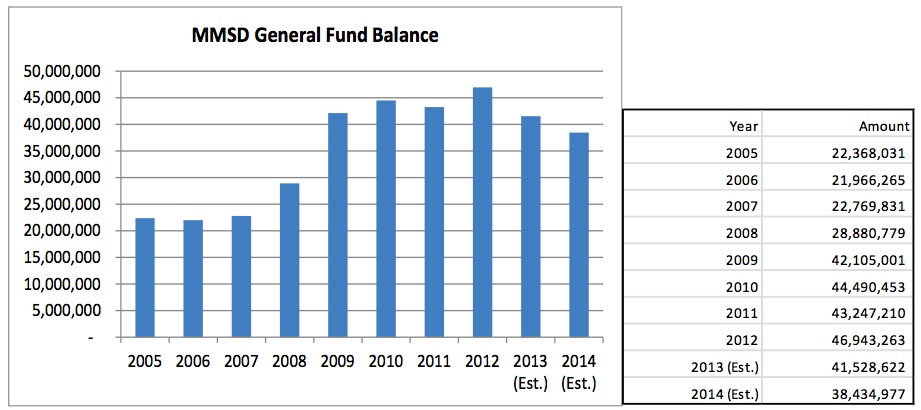
- Outbound open enrollment continues to grow, up 14% to 1,041 leavers in 2013 (281 inbound from other Districts).
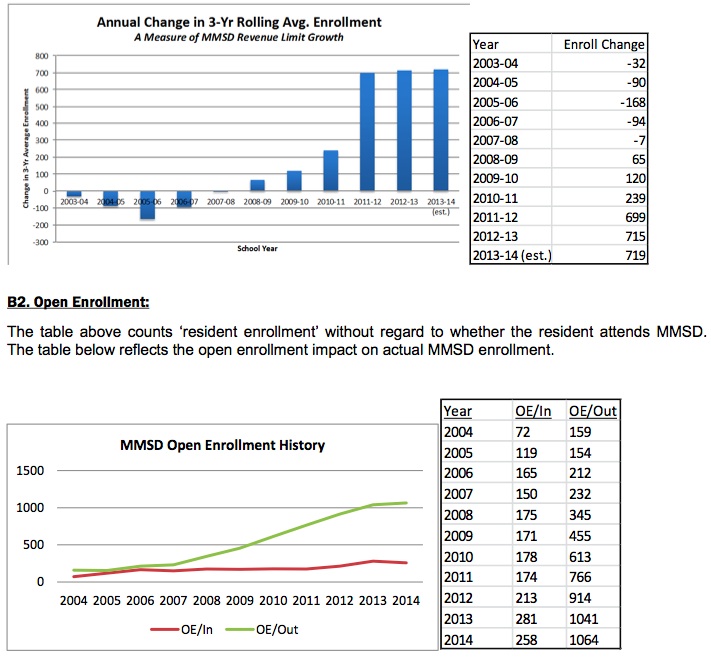
- There is no mention of the local tax or economic base:

- The growth in Fund 80 (MSCR) property taxes and spending has been controversial over the years. Fund 80, up until recently was NOT subject to state imposed property tax growth limitations.
- Matthew DeFour briefly summarizes the partial budget information here. DeFour mentions (no source referenced or linked – in 2013?) that the total 2013-2014 budget will be $391,000,000. I don’t believe it:
The January, 2012 budget document mentioned “District spending remains largely flat at $369,394,753” (2012-2013), yet the “baseline” for 2013-2014 mentions planned spending of $392,807,993 “a decrease of $70,235 or (0.02%) less than the 2012-13 Revised Budget” (around $15k/student). The District’s budget generally increases throughout the school year, growing 6.3% from January, 2012 to April, 2013. Follow the District’s budget changes for the past year, here.
Finally, the document includes this brief paragraph:
Work will begin on the 2014-15 early this fall. The process will be zero-based, and every line item and FTE will be carefully reviewed to ensure that resources are being used efficiently. The budget development process will also include a review of benefit programs and procurement practices, among other areas.
One hopes that programs will indeed be reviewed and efforts focused on the most urgent issues, particularly the District’s disastrous reading scores.
Ironically, the recent “expert review” found that Analysis: Madison School District has resources to close achievement gap. If this is the case (and I agree with their conclusion – making changes will be extraordinarily difficult), what are students, taxpayers and citizens getting for the annual tax & spending growth?
I took a quick look at property taxes in Middleton and Madison on a $230,000 home. A Middleton home paid $4,648.16 in 2012 while a Madison home paid 16% more, or $5,408.38.
As the Madison school year starts, a pair of predicaments
Paul Fanlund, via a kind reader:
In fact, the changing face of Madison’s school population comes up consistently in other interviews with public officials.
Police Chief Noble Wray commented recently that gang influences touch even some elementary schools, and Mayor Dave Cieslewicz expressed serious concern last week that the young families essential to the health and vitality of Madison are too often choosing to live outside the city based on perceptions of the city’s schools.
Nerad says he saw the mayor’s remarks, and agrees the challenge is real. While numbers for this fall will not be available for weeks, the number of students who live in Madison but leave the district for some alternative through “open enrollment” will likely continue to grow.
“For every one child that comes in there are two or three going out,” Nerad says, a pattern he says he sees in other urban districts. “That is the challenge of quality urban districts touched geographically by quality suburban districts.”
The number of “leavers” grew from 90 students as recently as 2000-01 to 613 last year, though the increase might be at least partly attributed to a 2007 U.S. Supreme Court ruling that greatly curtailed the ability of school districts to use race when deciding where students will go to school. In February 2008, the Madison School Board ended its long-standing practice of denying open enrollment requests if they would create a racial imbalance.
Two key reasons parents cited in a survey last year for moving children were the desire for better opportunities for gifted students and concerns about bullying and school safety. School Board member Lucy Mathiak told me last week that board members continue to hear those two concerns most often.
Nerad hears them too, and he says that while some Madison schools serve gifted students effectively, there needs to be more consistency across the district. On safety, he points to a recent district policy on bullying as evidence of focus on the problem, including emphasis on what he calls the “bystander” issue, in which witnesses need to report bullying in a way that has not happened often enough.
For all the vexing issues, though, Nerad says much is good about city schools and that perceptions are important. “Let’s be careful not to stereotype the urban school district,” he says. “There is a lot at stake here.”Related: the growth in outbound open enrollment from the Madison School District and ongoing budget issues, including a 10% hike in property taxes this year and questions over 2005 maintenance referendum spending.
The significant property tax hike and ongoing budget issues may be fodder for the upcoming April, 2011 school board election, where seats currently occupied by Ed Hughes and Marj Passman will be on the ballot.
Superintendent Nerad’s statement on “ensuring that we have a stable middle class” is an important factor when considering K-12 tax and spending initiatives, particularly in the current “Great Recession” where housing values are flat or declining and the property tax appetite is increasing (The Tax Foundation, via TaxProf:The Case-Shiller index, a popular measure of residential home values, shows a drop of almost 16% in home values across the country between 2007 and 2008. As property values fell, one might expect property tax collections to have fallen commensurately, but in most cases they did not.
Data on state and local taxes from the U.S. Census Bureau show that most states’ property owners paid more in FY 2008 (July 1, 2007, through June 30, 2008) than they had the year before (see Table 1). Nationwide, property tax collections increased by more than 4%. In only four states were FY 2008’s collections lower than in FY 2007: Michigan, South Carolina, Texas and Vermont. And in three states–Florida, Indiana and New Mexico–property tax collections rose more than 10%.It will be interesting to see what the Madison school District’s final 2010-2011 budget looks like. Spending and receipts generally increase throughout the year. This year, in particular, with additional borrowed federal tax dollars on the way, the District will have funds to grow spending, address the property tax increase or perhaps as is now increasingly common, spend more on adult to adult professional development.
Madison’s K-12 environment is ripe for change. Perhaps the proposed Madison Preparatory Academy charter school will ignite the community.
